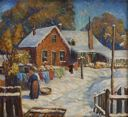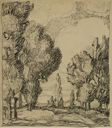Calvin Fletcher does not have an image.
Calvin Fletcher
(Provo, Utah, 1882 - 1963, Logan, Utah )
Calvin Fletcher was a shy child whose artistic gifts were apparent early in his life. Although he was most interested in sculpture, no local teachers were available, so his parents arranged lessons with the painter J. B. Fairbanks who had a studio in Provo. A year later Fletcher entered Brigham Young Academy, from which he received a "certificate in normal drawing." He then attended Brigham Young University and graduated two years later with both a Bachelor of Science and a certificate in Fine Arts. While attending BYU, he had taught as an assistant professor of art and manual training, and he continued to teach for a year after his graduation, before leaving to study at New York's Pratt Institute. Fletcher and his wife Sarah spent just one year in the East before returning to Utah where Calvin had been offered the chance to head the art department at Utah State Agricultural College, later Utah State University. Fletcher remained in Logan until 1912 when he took a sabbatical and returned to New York, this time alone, Sarah having died in 1909. While in New York, Calvin Fletcher studied with Charles Binnes at Columbia and under Robert Henri in evening classes. Having expanded his artistic exposure considerably, Fletcher then moved to London to work with Sir William Rothenstein and then to study at the Central School of Arts and Crafts with J. M. Doran, a textile designer. By May of 1913, Fletcher and five others were working in a rented studio in Paris, where Fletcher stayed until October. Fletcher returned to the United States, intending to take a position at the Art Institute of Chicago, but instead, he returned to Logan to chair the art department. For the next 30 years, Fletcher stayed home, although his literal orientation to nature gradually changed, largely because of broadening exposure from his own visiting artists program. In 1927, Fletcher had joined B. F. Larsen in a painting course at BYU, taught by a visiting instructor--a San Francisco-based artist, Lee R. Randolph. During the course of the workshop, Randolph had expressed concern about what he saw as the limited exposure of Utah artists to what was happening in the art world. Fletcher went home to Logan determined to change this limitation; to do so, he created an "artists-in-residence" program at Utah State that brought in artists from other areas of the country. The Swedish/Kansas artist Birger Sandzen was the first visiting artist. (Moonrise in the Canyon, Moab, Utah ) Initially, Fletcher was heavily influenced by Sandzen's "brilliant pure color, bold brushwork, and strong design. . . A cross between Neo-impressionism and the Fauvist painters of France." (See Fletcher's Wash Day in Brigham City ) His "Logan Artist Group" was made up of the most progressive painters in Utah, including Henri Moser and Reuben Reynolds. However, the influence was soon replaced by Depression era regionalism, which dominated the state in the 1930s. Over the years, the visiting artists program had the desired effects of exposing local artists to the modernist artistic developments in America and of increasing Utah artists' receptivity to non-traditional approaches. The years also brought a diversity to Fletcher's own artistic style. And if, as critics have noted, Fletcher never fully developed his own style, his open mindedness toward change and new ideas, as well as his natural compassion, made him a marvelous teacher. In 1926, Fletcher married his most promising student, a young woman named Irene Thompson. Fletcher had 2 children from his first marriage to Sarah and 6 from a second marriage--his second wife Zettie had died in childbirth--and he and Irene had 6 children, giving them a total of 14 children. Among the Fletchers' children are two who became artists themselves, Dale T. Fletcher and Elizabeth Fletcher Snow, painters and Robert Fletcher, a ceramicist. In spite of the time demands of a very large family, Irene Thompson Fletcher went on to become a successful artist in her own right. Calvin Fletcher will be remembered for his years of service to and innovation in the Utah State Art Department, to the Utah art scene, and as a representative on the national art scene. He was a member of national and local arts associations, served in various official capacities, won numerous local awards, and exhibited nationally. However, his most important contribution to Utah art is probably his public support for 'modern forms of art interpretation."
(Provo, Utah, 1882 - 1963, Logan, Utah )
Calvin Fletcher was a shy child whose artistic gifts were apparent early in his life. Although he was most interested in sculpture, no local teachers were available, so his parents arranged lessons with the painter J. B. Fairbanks who had a studio in Provo. A year later Fletcher entered Brigham Young Academy, from which he received a "certificate in normal drawing." He then attended Brigham Young University and graduated two years later with both a Bachelor of Science and a certificate in Fine Arts. While attending BYU, he had taught as an assistant professor of art and manual training, and he continued to teach for a year after his graduation, before leaving to study at New York's Pratt Institute. Fletcher and his wife Sarah spent just one year in the East before returning to Utah where Calvin had been offered the chance to head the art department at Utah State Agricultural College, later Utah State University. Fletcher remained in Logan until 1912 when he took a sabbatical and returned to New York, this time alone, Sarah having died in 1909. While in New York, Calvin Fletcher studied with Charles Binnes at Columbia and under Robert Henri in evening classes. Having expanded his artistic exposure considerably, Fletcher then moved to London to work with Sir William Rothenstein and then to study at the Central School of Arts and Crafts with J. M. Doran, a textile designer. By May of 1913, Fletcher and five others were working in a rented studio in Paris, where Fletcher stayed until October. Fletcher returned to the United States, intending to take a position at the Art Institute of Chicago, but instead, he returned to Logan to chair the art department. For the next 30 years, Fletcher stayed home, although his literal orientation to nature gradually changed, largely because of broadening exposure from his own visiting artists program. In 1927, Fletcher had joined B. F. Larsen in a painting course at BYU, taught by a visiting instructor--a San Francisco-based artist, Lee R. Randolph. During the course of the workshop, Randolph had expressed concern about what he saw as the limited exposure of Utah artists to what was happening in the art world. Fletcher went home to Logan determined to change this limitation; to do so, he created an "artists-in-residence" program at Utah State that brought in artists from other areas of the country. The Swedish/Kansas artist Birger Sandzen was the first visiting artist. (Moonrise in the Canyon, Moab, Utah ) Initially, Fletcher was heavily influenced by Sandzen's "brilliant pure color, bold brushwork, and strong design. . . A cross between Neo-impressionism and the Fauvist painters of France." (See Fletcher's Wash Day in Brigham City ) His "Logan Artist Group" was made up of the most progressive painters in Utah, including Henri Moser and Reuben Reynolds. However, the influence was soon replaced by Depression era regionalism, which dominated the state in the 1930s. Over the years, the visiting artists program had the desired effects of exposing local artists to the modernist artistic developments in America and of increasing Utah artists' receptivity to non-traditional approaches. The years also brought a diversity to Fletcher's own artistic style. And if, as critics have noted, Fletcher never fully developed his own style, his open mindedness toward change and new ideas, as well as his natural compassion, made him a marvelous teacher. In 1926, Fletcher married his most promising student, a young woman named Irene Thompson. Fletcher had 2 children from his first marriage to Sarah and 6 from a second marriage--his second wife Zettie had died in childbirth--and he and Irene had 6 children, giving them a total of 14 children. Among the Fletchers' children are two who became artists themselves, Dale T. Fletcher and Elizabeth Fletcher Snow, painters and Robert Fletcher, a ceramicist. In spite of the time demands of a very large family, Irene Thompson Fletcher went on to become a successful artist in her own right. Calvin Fletcher will be remembered for his years of service to and innovation in the Utah State Art Department, to the Utah art scene, and as a representative on the national art scene. He was a member of national and local arts associations, served in various official capacities, won numerous local awards, and exhibited nationally. However, his most important contribution to Utah art is probably his public support for 'modern forms of art interpretation."
Artist Objects















